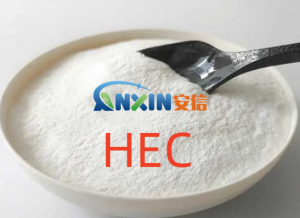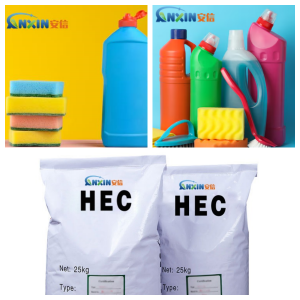Hydroxyethyl cellulose (HEC) is a non-ionic, water-soluble polymer compound obtained by chemical modification of natural cellulose. Due to its excellent thickening, emulsifying, suspending, stabilizing, and compatibility properties, HEC is widely used in the daily chemical industry, especially in liquid cleaning products such as dishwashing liquids, hand soaps, and shampoos.
1. Functional Role of HEC in Dishwashing Liquids
In dishwashing liquid formulations, the main functions of HEC include the following:
Thickening and Regulation: HEC effectively increases the viscosity of the dishwashing liquid system, giving the product a good appearance, flowability, and user experience.
Suspension Stabilization: In dishwashing liquids containing particulate additives (such as exfoliating particles and pearl powder), HEC can prevent particle sedimentation and maintain formulation homogeneity.
Foam Stabilization: HEC can synergistically work with surfactants to improve the fineness and persistence of foam.
Compatibility Adjustment: As a nonionic polymer, HEC is highly compatible with anionic, cationic, and nonionic surfactants, preventing formulation stratification.
2. HEC Stability Mechanism
2.1. Thermal Stability
HEC exhibits superior thermal stability compared to most natural polymers. In daily chemical systems at 25–50°C, HEC maintains stable molecular structure and is not easily degraded.
Even in high-temperature production (such as during the melting and heating stage) or long-term storage environments, HEC-thickened systems maintain good viscosity without significant thinning. This characteristic is particularly important for the stable sales of detergents during high-temperature transportation or in southern markets.
2.2. Ionic Stability
Dishwashing liquids often contain various inorganic salts (such as sodium chloride and sodium sulfate) and electrolyte components. These ions often weaken the effect of ordinary thickeners. However, as a nonionic polymer, HEC thickening performance is almost unaffected by changes in electrolyte concentration.
In high-salt systems, HEC still maintains stable viscosity and transparency, preventing salt precipitation and stratification in detergents during storage.
2.3. pH Stability
The pH of dishwashing liquids is generally between 6.5 and 8.5. HEC exhibits excellent chemical stability within this range, without degradation or inactivation. Even in the presence of slightly alkaline or acidic substances in the formulation, the HEC molecular chains maintain strong hydration, preserving the homogeneity of the system.
Furthermore, the nonionic nature of HEC avoids charge interference caused by pH fluctuations, ensuring the dishwashing liquid remains clear over a long period.
2.4. Compatibility Stability
HEC exhibits excellent compatibility with various surfactants (such as AES, LAS, APG, etc.) without causing flocculation or stratification. Its molecular chains can form weak interactions with surfactants in solution, thereby improving the viscoelasticity and foam stability of the system.
In complex systems containing compound fragrances, pigments, and preservatives, HEC maintains good dispersibility, preventing phase separation or precipitation during long-term storage.
3. Key Factors Affecting HEC Stability
3.1. Degree of Substitution (DS) and Viscosity Grade:
High-substitution-degree HECs offer better solubility and salt tolerance, making them suitable for transparent detergent formulations; low-substitution-degree products have stronger thickening capabilities but slightly lower stability. Generally, HECs with medium to high viscosity (25000–60000 mPa·s) are chosen to better balance thickening and transparency.
3.2. Dissolution Process:
HEC should first be evenly dispersed in cold water, then slowly heated to dissolve completely, avoiding clumping. Incomplete dissolution can easily lead to particulate matter or turbidity in the system, thus affecting formulation stability.
3.3. Formulation Electrolyte Concentration:
Although HEC has good salt tolerance, a slight decrease in viscosity may still occur when the electrolyte concentration in the system is too high (>6% NaCl). Therefore, in high-salt formulations, the amount of HEC added should be appropriately increased, or a modified HEC variety should be selected.
3.4. Surfactant Type:
The compatibility of HEC with different surfactant systems varies slightly. For example, HEC exhibits superior foam stability in LAS and AES systems; while in environmentally friendly dishwashing liquids containing APG, HEC thickening and suspending effects are more prominent.
4. Advantages of HEC in Dishwashing Liquids
High System Transparency: The dissolved aqueous solution is clear and transparent, not affecting the visual appearance of the dishwashing liquid.
Good Biodegradability: Derived from natural cellulose, it aligns with the trend of environmentally friendly daily chemical products.
Low Irritation: It does not cause skin allergies and is suitable for mild dishwashing liquid formulations.
Wide Compatibility: Applicable to different types of dishwashing liquid systems, such as neutral dishwashing liquids, concentrated formulas, and high- or low-foaming formulations.
HEC is not only an excellent thickener in dishwashing liquid formulations but also a key system stabilizer. Its excellent thermal stability, ionic stability, pH stability, and compatibility ensure that dishwashing liquids maintain good appearance and performance during storage, transportation, and use. By rationally selecting HEC types and addition processes, the overall quality and market competitiveness of dishwashing liquids can be significantly improved. In the future, with the development of green environmental protection and sustainable chemistry, HEC will show broader application prospects in high-end detergent products.
Post time: Nov-03-2025

